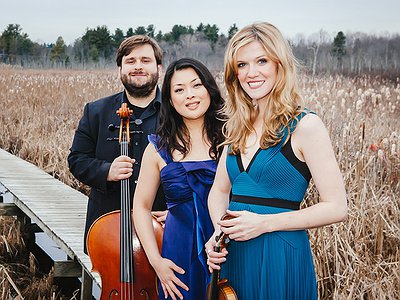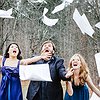Name: Neave Trio
Members: Anna Williams, Mikhail Veselov, Eri Nakamura
Nationality: American, Russian, Japanese
Occupation: Violinist, Cellist, Pianist
Current Release: Celebrating Piazzolla on Azica
If you enjoyed this interview with the Neave Trio, visit their website for updates, music and biographical information.
When did you start playing your instrument, and what or who were your early passions and influences? What is about music and/or sound that drew you to it?
Mikhail Veselov, cello: Anna started violin when she was six. Eri was four when she began playing piano. I started piano at three and was always drawn to cello. I always felt it had such warmth and similarity to the human voice and just loved it, so when I was ten I finally asked my parents if I could sign up for cello lessons. I was so lucky to have wonderful teachers and I still think of many specific lessons that I had during my time studying cello. I loved listening to recordings of Yo-yo Ma and Jacqueline du Pré and tried to get my hands on any recordings I could find.
All three of us are absolutely in love with the medium of Piano Trio, as it allows us to take on many roles and experience anything from quintessential chamber music, to orchestral, to solo playing. We are also so lucky to have an abundance of incredible repertoire, from the beloved “staples” of Brahms and Beethoven trios to lesser known gems like Foote and Roussel and 21st-century compositions, many of which we have had the privilege to premiere. There is always something new to discover.
For most artists, originality is first preceded by a phase of learning and, often, emulating others. What was this like for you? How would you describe your own development as an artist and the transition towards your own voice? What is the the relationship between copying, learning and your own creativity?
Anna Williams, violin: Like most little ones starting an instrument, especially a string instrument, there was such a long period of trying to “get it right” that was my early experience. It took what felt like forever to learn to hold the bow effectively, to have correct posture, to create a nice tone and to play in tune - all of which came before playing any real music!
At the same time, from an early age I was amazed by great players - not just violinists but lots of musicians who I would listen to on the radio during car rides with my mom. All of which is to say that I think there is a natural inclination for young musicians to seek the “gold star” of approval from their teachers while also looking up to great musicians. The trouble is when that mindset sticks around past its sell-by date. At a certain point, if you have had the blessings of good teachers, they encourage you to be yourself and to trust your instincts, training and knowledge in interpreting and music making. I think the best teachers know when to let go and allow you to really own your process, opinions and musical choices: they free you to be your true self in music making, backed by all your knowledge and training.
In terms of being inspired and initially wanting to copy, I think that’s very much the case when you’re little since you are looking for role models. For me, I remember not only being so enamored with my teachers and wanting to sound like them, but also remember when a family friend gave me some recordings of Anne Sophie Mutter and I was enthralled! As you progress in your artistic path, I think it’s important to listen, listen, listen – not only to your favorite artists (Mutter is still one of my all-time favorites!) but also to less familiar artists since they can point something out that you may have missed. Sometimes hearing something that you don’t love can be just as informative as listening to a performance that you adore because it helps you to define what it is that you like and consequently help you search for that in your own playing!
At the end of the day, you have to trust your training and intuition when you’re playing. Despite taking in all the influences you can, if you’re trying to sound like anyone but you, it will not feel authentic.
What were some of your main artistic challenges when starting out as an artist and in which way have they changed over the years?
Anna Williams, violin: As an individual, I would say the idea of transitioning away from trying to get the gold star or to be “right” (whatever that means!) in the eyes of teachers and at some point trusting that you are your own best teacher, and that your musical voice and opinion is valid was really a challenging but ultimately rewarding process. Trusting that, both as an individual and within our trio, in both practice and rehearsals, allows us to take risks and rely on each other’s feedback which leads to more authentic music making - and that, after all, is the whole goal!
Tell us about your studio/work space, please. What were criteria when setting it up and how does this environment influence the creative process? How important, relatively speaking, are factors like mood, ergonomics, haptics and technology for you?
Eri Nakamura, piano: We are a faculty ensemble-in-residence at the Longy School of Music at Bard College. With Longy as our home base, we get to rehearse in a different room every day, which we find helpful so as to not let us get used to a specific feel of a room. Every space is acoustically different, and also has a different piano, just in the same way that every concert hall we play in is so different and requires adjustment. It is a great opportunity for us to be able to adjust our balance and sound and experience playing in different spaces, just as we have to do when we go on tour.
Tell me about your instrument, please. What was your first instrument like and how did you progress to your current one? How would you describe the relationship with it? What are its most important qualities and how do they influence the musical results, including your own performance?
Anna Williams, violin: I am very lucky to get to play on an old Italian violin (1794 J and A Gagliano. I really fell in love with this violin at first sight when I was trying it amongst many other fiddles without knowing what it was. I loved its mellow, earthy, human sound! The intimacy and warmth of its tone really spoke to me. I think in terms of my relationship to the instrument, at first I was trying to play on it in the same way as I had with other student fiddles. But this violin actually taught me what it would need and what brought out its best - even if that wasn’t always “by the book”. I think that’s one of the blessings – though sometimes a challenge – of older, personality-full instruments. They can be very exacting, but if you listen to what it is they actually need by way of technique and don’t try to change the core of its sound the result can be very fulfilling. I always try to sound as human as I can. Every moment of every piece calls for something very specific and different, but I always try to emulate singing or speaking. Whether as an extroverted singer, belting a fabulous melody or an intimate lullaby or even a whisper to a loved one - the vocal qualities are what I’m always searching for. Thankfully, my violin is one that helps me to do that.




